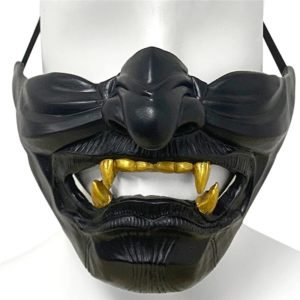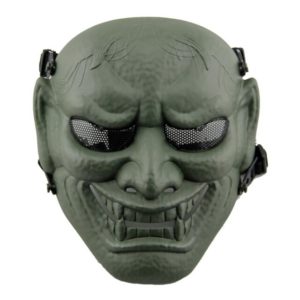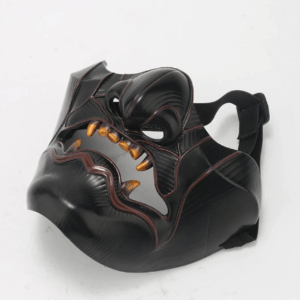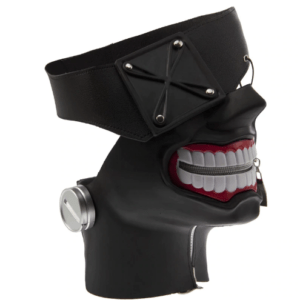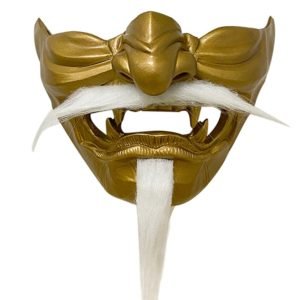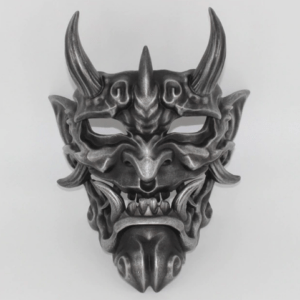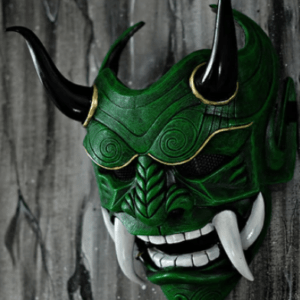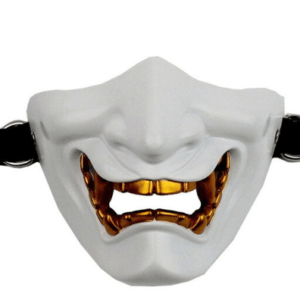Samurai Masks for Sale
Showing all 8 results
-
SALE 25%

Black Ghost TS Samurai Mask
Original price was: $74.99.$55.95Current price is: $55.95. Buy Now -
SALE 47%

Ghost King Samurai Skull Full Face Mask
Original price was: $74.95.$39.95Current price is: $39.95. Buy Now -
SALE 28%

Ghost of Tsushima Sakai Half Face Samurai Mask
Original price was: $89.95.$64.95Current price is: $64.95. Buy Now -
SALE 42%

Ghoul Kaneki Ken Samurai Mask
Original price was: $59.95.$34.95Current price is: $34.95. Buy Now -
SALE 39%

Gold Ghost TS Samurai Mask
Original price was: $74.99.$45.95Current price is: $45.95. Buy Now -
SALE 35%

Kabuki Samurai Devil Mask
Original price was: $114.95.$74.95Current price is: $74.95. Buy Now -
SALE 36%

Latex Samurai Devil Mask
Original price was: $54.95.$34.95Current price is: $34.95. Buy Now -
SALE 45%

Tooth Decay Evil Samurai Half Cover Mask
Original price was: $54.95.$29.95Current price is: $29.95. Buy Now
Authentic Japanese Samurai Mask Collection
Japanese Samurai Masks are a part of traditional Japan and their origins go back times. Samurai Masks are also a representation of the rich cultural values of Japan and symbolize its history.
History of Warrior Masks
Armor was a major part of Japanese Samurai Culture. It provided them with security and protection in the battlefields and in times of war but more importantly, it represented their mythology and art.
The armors were made of steel to prevent any advancements but in a way that provided complete flexibility and mobility, usually, an upturned crescent decorated the helmet and the face was covered with a leather or steel mask.
During the 11th Century, the Happuri style of face mask was popular and its main purpose was to protect the temples and the forehead. The designs and creativeness did not reach its peak during the early times rather simple and minimalistic work was preferred by the warriors.
Then in the 13th – 15th Century, the Muromachi Era, several types of masks gained popularity. Some of them are;
Hoate
Samurai Mask that covered everything below the eyes.
Mempo
These masks covered the whole face.
Sarubo
These covered only the chin and cheeks and were also known as ‘monkey cheek’.
Tsubamegata
More commonly known as the ‘swallow pattern’ used to cover nothing but the chins
As this era was primarily based upon war and fighting, decorating and adorning the mask was not a priority rather the safety and protection that the piece of armor provided was valued.
In the 14th century, the creation of masks took a new turn and mostly realistic human looking masks gained popularity. The old warriors wore and preferred masks that gave a younger appearance and the younger preferred those which made them look older.
Masks were even made to make people look of different ethnicities like a Korean man which then used to help them in different, secret disguises.
Some masks even made them disguise themselves as women but mostly warriors were afraid of their heads being thrown away and not preserved as a trophy if they died in a woman disguise for which they decorated them with moustaches.
In the Edo period, mostly the masks were more used for creating a certain image rather than using for protection as those were peaceful times. Masks usually depicted the personality of the wearer, for instance, warriors with a fierce and aggressive nature mostly wore the masks of Tengu.
Other masks that became prominent were ghost masks, demon masks and mountain goblin masks. The masks in this era usually said a lot about the nature of the person wearing it.
Making of Samurai War Mask
The making of the Samurai Mask was a special thing and required long and extensive hard work to get the details right. Iron was the main element that the mask was based upon and all of them had to be waterproof to prevent rusting of the mask and helmet.
The four main components of the mask were;
Odome and Ori-Kugi
An attachment post and hook that secured the chin part of the mask to the whole helmet.
Ase Nagashi
A tiny hole at the base of the chin that was made in order to drain an excessive sweat during the battles.
Yodare-kake
This part was made to serve as a neck-guard but was attached to the face mask and was made of iron which would be lacquered
The nose of the mask was made separately and attached on to the mask in order for the wearer to easily remove it when suitable.
Types of Warriors
Approximately all the Samurai warriors wore the armor which consisted of the chest and backplate, the neck plate and helmet and the mask. Some of the famous warriors include Oda Nobunaga, Toyotomi Hideyoshi, Date Masamune and Uesugi Kenshin.
Oda Nobunaga
Oda Nobunaga is also known as the first ‘Great Unifier of Japan’. He was a Daimyo and a prominent figure of the Sengoku Period. He was also the leader of a powerful clan, the Oda clan.
Rising in power he crushed many rebels and conquered many lands. Civil government and free trade were reintroduced in his era along with the encouragement of arts and history and new military tactics. He also initiated the Azuchi-Momoyama period in Japan.
Toyotomi Hideyoshi
Toyotomi Hideyoshi is also known as the second ‘Great Unifier of Japan’ and succeeded Oda Nobunaga. He was a political leader and a Daimyo of the Sengoku Period.
Hideyoshi was from a poor background but worked under Nobunaga where he gained power and followed the steps of his master. Hideyoshi became a prominent name and also attacked Korea.
Date Masamune
Date Masamune was known as the ‘One-Eyed Dragon’ as he was infected with smallpox in his childhood and lost his eye which he later on gouged out. He joined the forces of Hideyoshi for the Siege of Korea.
He and his forces were best known for their armor which was famous for instilling fear in the hearts of enemies.
Uesugi Kenshin
Uesugi Kenshin was daimyo and ruled the Echigo Province in the Sengoku Period. He was extremely good in the battles and as a good administrator.
He supported local trade and businesses. Kenshin was also known as the ‘God of War’ because of his multiple campaigns and expertise in the battlefield.
Where to buy Mempo Masks
Mempo Masks are a part of traditional Japan and represent their rich culture. These are easily available at our shops and website at one of the best prices and amazing quality as it is our top priority to provide our customers with the finest quality leaving them satisfied. You can visit us at Kabuki Mask to find what you are searching for.
Get free & fast Shipping
Japanese Samurai Masks are available for free and fast shipping. Customers are the most essential part of any business and keeping that in view, we try our level best to see what works best for them.
Our free and fast shipping service presents free of cost delivery in a reasonable time period making the experience much more worthy.

